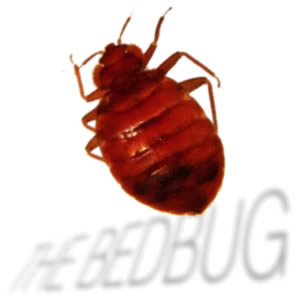The Bedbug
(parasite)
common bedbug, cimex lectularius
Key features
Adult bedbugs are 4 - 5 mm in length, wingless and
uniformly mahogany brown in color. They have long
well-developed walking legs with efficient tarsal claws
for clinging on to the host during feeding. Prominent antennae project from the head adjacent to the compound eyes.
Biology
Female bedbugs lay eggs throughout their life, an unusual feature in insects. They generally produce around 2 to 3 per day and since they can live for many weeks, indeed months, each female could produce around 400 - 500 eggs during her lifetime. The eggs are deposited all around the environment in which the bedbug is living and are small and white or whitish/yellow about 1 mm long. The nymph which emerges from the eggs after about ten days at 22°cC is a
small version of the adult feeding also on the blood of vertebrates. The length of time spent in the five nymphal stages is greatly dependant on the food resources available, temperature and relative humidity.
Bedbugs have well defined resting sites in which many individuals from all the different life stages are found. This harborage is an essential part of the life cycle of the insect since it is in this area that the young bedbugs pick up the internal gut microorganisms which are essential to there survival.
Distribution
This genus has representatives worldwide.
Significance
The close association of bedbugs with human beings means that they cause substantial nuisance through their blood-feeding habit. They fed at night on their human hosts as they are sleeping. If the infestation is high there can be a risk of anemia being suffered by the human hosts, although this is rare. The nuisance and itching caused by the bites and the possibility of secondary infection is more common. Bats, chicken and other domesticated animals may also be attacked.
Control
A thorough inspection should be made to determine the extent and source of the infestation, Bedbugs may, for instance, have been introduced in second-hand furniture, where bugs may remain undetected for considerable periods until a suitable host appears. All harborages should be treated with a residual insecticide.
A very thorough treatment is needed as harborages are diverse and difficult to detect.
Instructions for BED BUG treatment.
1. The carpeting and floor should also be toughly vacuumed, particularly along the baseboards using a crack & crevice attachment. The vacuum bag should dispose immediately in a sealed plastic bag in an outdoor trash receptacle.
2. All sheets and bedding material (and pillows) should be removed from the beds and sealed in plastic trash bags until they can be washed or dried. If bed bugs are hiding within the bedding, this helps to prevent spreading the bugs to other rooms.
3. Sheets and bedding can be washed in soap and hot water. Bed spreads, covers and other items that cannot be washed should be dried in the dryer at high temperature for one hour. (This step will also be necessary for clothing stored beneath beds or in dressers that are found to have bed bugs harboring within them) Cleaning instructions on the clothing tags on all items should be followed.
4. Drapes in infested rooms should also be bagged and then dried in a dryer at high temperature for at least one hour.
5. The mattress and box spring should be leaned against the wall. Bed bugs can hide in small cracks anywhere within the box springs and bed frame so beds should be dismantled to allow access for thorough inspection and treatment.
6. Heavy furniture should be moved 18 inches away from walls to allow access for inspection treatment.
7. Dragging/moving mattresses and box springs thorough a hall way could result in bed bugs falling off during the transit and creating a more wide-spread infestation. All items removed from rooms should be completely wrapped in plastic before removal.
8. Please make sure that all procedures above are completed before we come to do treatment in your house. Thank you for all your cooperation.
9. Residents will need to remove all animals (birds, cats, turtles, etc.).
10. Residents will need to leave the house during the treatment and remain out of the house for (4) four hours after the treatment has been performed.
Sincerely
A-PRO






